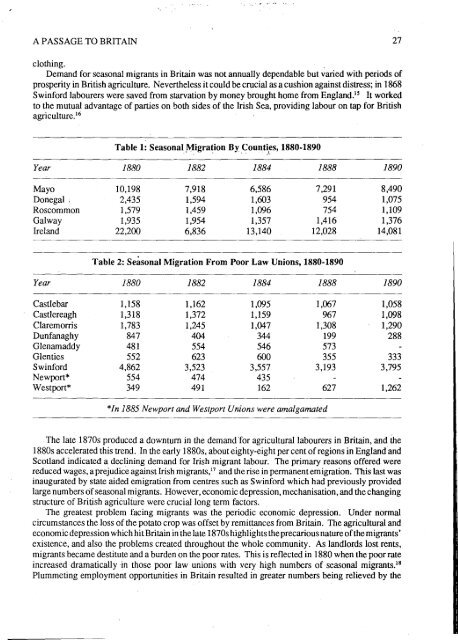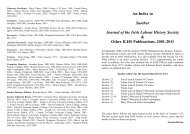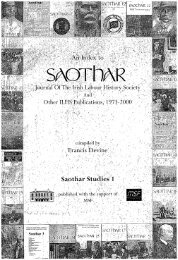26 SAOTHAR 13shopkeepers, clergy and railwaymen. In Mayo up to 50,000, or twenty percent of the population, reliedheavily on migration. It was a dependency which continued unabated into the 1890s.Although figures do not exist, it would appear that the 1860s and 1870s were the peak periods formigration, providing an income of between £0.8 million and £1 million to the economy of the west andnorthwest. Income was not always uniform however. Regional factors occasionally caused their ownproblems for migrants as in 1884 when the mangold and turnip crop in England failed, causing severehardship for their harvesters, the Swinford migrant labourers.12Despite the apparent benefits of an external income, seasonal migration cannot be said to haveelevated the social or economic circumstances of the source regions. While the Great Famine is oftencited as ~e pivotal point of Irish history, it must be emphasised that this was not true for many of themore remote and poorer regions of the country. In communities reliant on seasonal migration, thesubdivision of holdings and other characteristics of pre-famine society persisted. Migration, by itsstructural nature, could not improve the living standards of its participants. Migrants failed to rise abovea subsistence living in Ireland. Their readiness to pay a rent which greatly exceeded the returns fromtheir holdings clearly points to a general inability to raise their economic position. This is more than. evident in the case of Achill Island.The Achill community depended heavily on earnings from seasonal migration, which averaged £ 10per person per annum. After an adequate potato crop had been planted, populations of whole town landswere then known to leave for Scotland for periods of four to five months. Children left as young asthirteen years and in many instances the only permanent residents on the island were the very old wholooked after those too young to travel with their parents. This phenomenon gave rise to the observationof many English officials that the migrants were in essence labourers who, through legal andcommunity ties, were forced to use Ireland as winter quartersP There was little or no incentive forthe labourers to ameliorate their condition during their stay in Achill, and in view of this many outsidersviewed them as lazy, and disinterested in improving their lot. It was difficult if not impossible for themto eke out an existence on the island, which was described by the Irish Daily Independent in 1894 as:' ... a stinking patch of bog and barren soil, yielding only stones and stunted weeds and hemmed in by tallhills, presenting here and there rocky fronts to the Atlantic and making sunless valleys dark and rugged,with scarce a vestige of grass - all hard rock - refusing to yield to labour even the smallest return in fruit.... There are 6,000 people living in the most miserable hovels that sheltered man or woman, worse thanman builds for his dog or fowl, getting not a penny, one might say with considerable truth, for the land forwhich they nevertheless pay rent .,.. The villages of Achill' swarm with people living under suchcon di tions. >14Despite the shortcomings of the seasonal migration system and the short term gains of the migrants,there were of course financial advantages. It enabled the migrants to pay their rent, and in addition asubstantial proportion of the season's earnings was spent on foodstuffs. The migrant found himselfintroduced to new commodities such as tea, sugar and strong beer, commodities which were seldomif ever part of his diet in Ireland. The introduction of these' new elements to migrants' lifestyles wasa contributory factor in encouraging many to settle permanently in Britain. Many observers, such asShaw of the Bessborough Commission, saw the migrants in essence as English, rather than Irish,labourers.The gradual assimilation of previously unknown ideas and customs can also be discerned in theintroduction of new elements into the diet, clothing and lifestyle of the Irish communities back home.The wearing of cheap cotton, easil y washable clothes, such as those worn by their English counterparts,bore tangible witness to the migrants' contact with Britain. This confirms the' fact that externalinfluences had not been introduced into remote areas exclusively by the higher social classes such aslandlords and clergy. Due to their first hand experience outside Ireland, lower social orders such as themigrant workers were improving aspects of their own lives, if not on the land, at least in diet and
A PASSAGE TO BRITAIN 27clothing._Demand for seasonal migrants in Britain was not annually dependable but varied with periods ofprosperity in British agriculture. Nevertheless it could be crucial as a cushion against distress; in 1868Swinford labourers were saved from starvation by money brought home from EnglandY It workedto the mutual advantage of parties on both sides of the Irish Sea, providing labour on tap for Britishagriculture. 16 Table 1: Seasonal)\1igration By Counties, 1880-1890. - - -. ~Year 1880 1882 1884 1888 1890Mayo 10,198 7,918 6,586 7,291 8,490Donegal, 2,435 1,594 1,603 954 1,075Roscommon 1,579 1,459 1,096 754 1,109Galway 1,935 1,954 1,357 1,416 1,376Ireland 22,200 6,836 13,140 12,028 14,081Table 2: Seasonal Migration From Poor Law Unions, 1880-1890Year 1880 1882 1884 1888 1890Castlebar 1,158 1,162 1,095 1,067 1,058Castlereagh 1,318 1,372 1,159 %7 1,098Claremorris 1,783 1,245 1,047 1,308 1,290Dunfanaghy 847 404 344 199 288Glenamaddy 481 554 546 573Glenties 552 623 600 355 333Swinford 4,862 3,523 3,557 3,193 3,795Newport* 554 474 435Westport* 349 491 162 627 1,262*In 1885 Newport and Westport Unions were amalgamatedThe late 1870s produced a downturn in the demand Jor agricultural labourers in Britain, and the1880s accelerated this trend. In the early 1880s, about eighty-eight per cent of regions in EnglandandScotland indicated a declining demand for Irish migrant labour. The primary reasons offered werereduced wages, a prejudice against Irish migrants,17 and the rise in permanent emigration. This last wasinaugurated by state aided emigration from centres such as Swinford which had previously providedlarge numbers of seasonal migrants. However, economic depression, mechanisation, and the changingstructure of British agriculture were crucial long term factors.The greatest problem facing migrants was the periodic economic depression. Under normalcircumstances the loss of the potato crop was offset by remittances from Britain. The agricultural andeconomic depression which hit Britain in the late 1870s highlights the precarious nature of the migrants'existence, and also the problems created throughout the whole community. Aslandlords lost rents,migrants became destitute and a burden on the poor rates. This is reflected in 1880 when the poor rateincreased dramatically in those poor law unions with very high numbers of seasonal migrants. lsPlummeting employment opportunities in Britain resulted in greater numbers being relieved by the
- Page 1 and 2: JOURNAL OF THE IRISH LABOUR HISTORY
- Page 3 and 4: ContentsPageEditorial: Labour Histo
- Page 5 and 6: EDITORIAL 3freedom to participate i
- Page 7 and 8: CorrespondenceThe Irish Labour Part
- Page 9 and 10: ; ~ ; ,The Decline and Fall of Donn
- Page 11 and 12: THE DECLINE AND FALL OF DONNYBROOK
- Page 13 and 14: THE DECLINE AND FALL OF DONNYBROOK
- Page 15 and 16: ·' THE DECLINE AND FALL OF DONNYBR
- Page 17 and 18: THE DECLINE AND FALL OF DONNYBROOK
- Page 19 and 20: THE DECLINE AND FALL OF DONNYBROOK
- Page 21 and 22: THE DECLINE AND FALL OF DONNYBROOK
- Page 23 and 24: THE DECLINE AND FALL OF DONNYBROOK
- Page 25 and 26: ,'-,;-''''.A PASSAGE TO BRITAIN 23C
- Page 27: A PASSAGE TO BRITAIN 25only in the
- Page 31 and 32: A PASSAGE TO BRITAIN 29established
- Page 33 and 34: ;:-.",.- .. .", ...... '.:. '
- Page 35 and 36: LOUIE BENNETI 33feminist movement w
- Page 37 and 38: :... ~: ."
- Page 39 and 40: -.- '.LOUlE BENNETT 37While there i
- Page 41 and 42: LOUIE ~ENNEIT 39Xl's encyclical Qua
- Page 43 and 44: LOUIE BENNEIT 41Bennett's own relat
- Page 45 and 46: LODIE BENNETT 43109; IWWU resolutio
- Page 47 and 48: Essays in ReviewCosherers, Wanderer
- Page 49 and 50: ••• .".'. >. '~"ESSA YS IN RE
- Page 51 and 52: ESSAYS IN REVIEW 49ConnolIy:Myth an
- Page 53 and 54: ESSAYS IN ~EVIEW 51tion' in the Int
- Page 55 and 56: ESSAYS IN REVIEW53International:'I
- Page 57 and 58: REVIEWScontroversy is real history.
- Page 59 and 60: REVIEWSJoe Monks was among the earl
- Page 61 and 62: REVIEWSnolly-Column Song','Proudly
- Page 63 and 64: REVIEWSresulting from the arrival o
- Page 65 and 66: REVIEWS,63the book by means of an a
- Page 67 and 68: REVIEWSlogue, it is hardly surprisi
- Page 69 and 70: The Team For All Workers ...CULIAIB
- Page 71 and 72: ESSAYS 69mission and moral refonn.l
- Page 73 and 74: .. ...... ~.~ -~ .'- '.ESSAYS. 71fr
- Page 75 and 76: ESSAYS 73claimed authority but whic
- Page 77 and 78: ESSAYS 75provided the basis for soc
- Page 79 and 80:
ESSAYS 779. For comparisons see E.T
- Page 81 and 82:
ESSAYS 7952. Annals of Christ Churc
- Page 83 and 84:
ESSAYS' 81Fianna Fail and the Worki
- Page 85 and 86:
ESSAYS 83Eireann in 1925 visibly di
- Page 87 and 88:
ESSAYS 85recognition of the impract
- Page 89 and 90:
ESSAYS 871970, it created the condi
- Page 91 and 92:
ESSAYS89The Irish Immigrants' Contr
- Page 93 and 94:
ESSAYS" 91Although anti -Catholic p
- Page 95 and 96:
ESSAYS 93McCowie played a key role
- Page 97 and 98:
:. -,,'.' ',. .~.,:.ESSAYS 95Althou
- Page 99 and 100:
ESSAYS 97young girl of their own ba
- Page 101 and 102:
SourcesIrish Labour History Society
- Page 103 and 104:
SOURCES 101INovember, 1971 to no. 1
- Page 105 and 106:
SOURCES 103would claim credit for t
- Page 107 and 108:
SOURCES105Sources for Irish Labour
- Page 109 and 110:
SOURCES 107NorthWest Archives and L
- Page 111 and 112:
SOURCES 109In 1966 the Finnish gove
- Page 113 and 114:
TURNINGANEWLEAFThe CPSSUis the larg
- Page 115 and 116:
REMINISCENCE 113us due to my politi
- Page 117 and 118:
REMINISCENCE 115when Jim was presen
- Page 119 and 120:
REMINISCENCE 117of Dail Eireann. 17
- Page 121 and 122:
REMINISCENCE 119NotesThe above arti
- Page 123 and 124:
DOCUMENT STUDY 121James Connolly in
- Page 125 and 126:
DOCUMENT STUDY123SOCIAL DEMOCRATIC
- Page 127 and 128:
DOCUMENT STUDY 125proletariat of th
- Page 129 and 130:
DOCUMENT STUDY 127the support of Je
- Page 131 and 132:
DOCUMENT STUDY 12926. The Workers'
- Page 133 and 134:
131BibliographyA Bibliography of Ir
- Page 135 and 136:
BIBLIOGRAPHY 133Compton, P.A. Demog
- Page 137 and 138:
BIBLIOGRAPHY 135Levine, I. and Madd
- Page 139 and 140:
BIBLIOGRAPHY 137Turner, M. 'Towards
- Page 141 and 142:
BIBLIOGRAPHY 1394. Land and Agricul
- Page 143 and 144:
BIBLIOGRAPHY 141Clogher Record12 (2
- Page 145 and 146:
BIBLIOGRAPHY 143Political Research
- Page 147 and 148:
BIBLIOGRAPHY 145Pres, 1987.O'Brien,
- Page 149 and 150:
147Notes on Contributorsf onathanBe
- Page 151 and 152:
1901: Ireland's first general union
- Page 153 and 154:
ELECTRICAL TRADES UNION .Establishe





